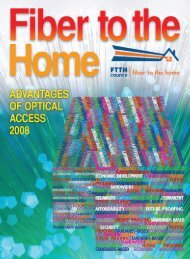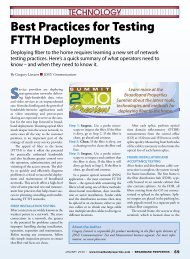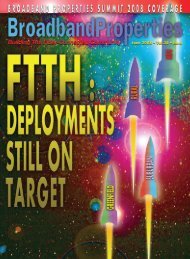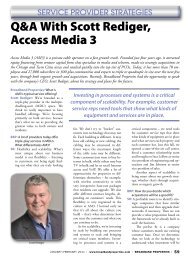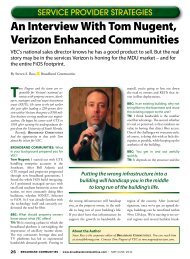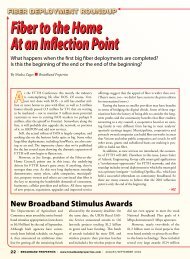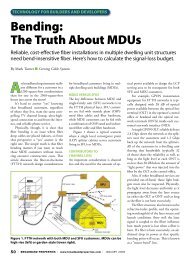2010 Buyers Guide - Broadband Properties
2010 Buyers Guide - Broadband Properties
2010 Buyers Guide - Broadband Properties
Create successful ePaper yourself
Turn your PDF publications into a flip-book with our unique Google optimized e-Paper software.
FTTH CONFERENCE COVERAGE<br />
Four Stimulus-Funding Applications<br />
RUS and NTIA rules “throw providers a bone,”<br />
giving them opportunities to serve rural towns if<br />
they also connect the outlying areas.<br />
The complex rules and definitions<br />
in the NTIA-RUS broadband<br />
Notice of Funding Availability<br />
(NOFA) left service providers scratching<br />
their heads in puzzlement. Were their<br />
service areas remote? Rural? Unserved?<br />
Underserved? Should they apply for<br />
loans or grants? RUS, NTIA, or both?<br />
To apply in the first funding window,<br />
providers had to answer these questions<br />
quickly and choose strategies that would<br />
give them a competitive leg up.<br />
Geoff Burke, marketing director at<br />
Calix, explained at the FTTH Conference<br />
how four Calix customers crafted<br />
their funding applications to meet these<br />
complex requirements, yielding insight<br />
into what the funding agencies were trying<br />
to achieve.<br />
Service Provider 1, a Midwestern<br />
CLEC, originally planned to build out<br />
fiber to two towns of 7,500 and 2,500<br />
households respectively. Although SP1<br />
considered these communities unserved,<br />
they were mostly served according to the<br />
NOFA’s low broadband threshold (768<br />
Kbps/256 Kbps). To become eligible for<br />
stimulus funding, SP1 proposed to cover<br />
only about 1,800 homes in the original<br />
target communities, adding about 550<br />
more homes in six small outlying areas.<br />
It constructed the service area somewhat<br />
artificially, stringing census blocks<br />
together so the overall area would have<br />
less than 40 percent broadband penetration<br />
and thus qualify as “underserved.”<br />
To get additional points for over-20<br />
Mbps service, it selected a GPON architecture.<br />
Burke commented that SP1’s<br />
apparent gerrymandering was precisely<br />
the result the agencies were hoping for:<br />
The NOFA, he said, “threw [SP1] the<br />
bone” of the town, a viable territory, so<br />
as to bring broadband to the unprofitable<br />
outlying areas.<br />
Service Provider 2, a Midwestern<br />
cooperative with both incumbent and<br />
competitive territories, saw an overbuild<br />
opportunity in a town of about 900<br />
homes. As in the first case, part of the<br />
town was served with broadband (by the<br />
NOFA standards) and part was not. SP2,<br />
however, included the entire town in its<br />
proposal by extending the borders of<br />
the proposed service area far outside the<br />
town – far enough for the unserved/underserved<br />
area to make up 75 percent of<br />
the total square mileage; it also selected<br />
GPON to provide over-20 Mbps service.<br />
Meeting the 75-percent standard qualified<br />
SP2 for a 50/50 loan/grant combination.<br />
Again, this achieves the agencies’<br />
goal of bringing broadband to outlying<br />
areas that would not have been viable<br />
without the anchor of the small town.<br />
Service Provider 3, a Midwestern<br />
cable television company serving an urban<br />
area, originally planned to expand<br />
its service area out into the suburbs with<br />
fiber-to-the-home infrastructure. Based<br />
on the NOFA, it skipped over the closein<br />
suburbs to select exurban, fringe areas<br />
containing about 5,000 households that<br />
could qualify as rural and underserved.<br />
Although this territory had no anchor<br />
town, its relative proximity to SP3’s urban<br />
territory made it a feasible choice.<br />
SP3 chose GPON because it could support<br />
RF video.<br />
Service Provider 4, an Eastern<br />
CLEC serving an urban area, was looking<br />
to expand its service to nearby urban<br />
areas. When the NOFA was issued,<br />
this provider changed its plans entirely.<br />
Instead, SP4 proposed a middle-mile<br />
project to bring fiber backbone from<br />
its original service area to two adjacent<br />
counties. It then proposed leveraging<br />
the middle-mile project to pick up 1,000<br />
rural, underserved households along the<br />
way and deliver GPON-based services<br />
to them. BBP<br />
November/December 2009 | www.broadbandproperties.com | BROADBAND PROPERTIES | 53



